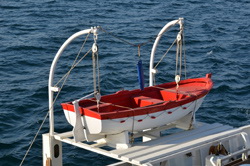Better life-saving systems for ship evacuations
The 'Safe abandoning of ships, improvement of current life saving appliances systems' (Safecrafts) project focused on the improved design of rescue systems for ship passengers and crew with a view to enhanced safety levels. The EU-funded project worked to advance the evacuation system in terms of passenger/crew survivability on the strength of conceptual improvements to current life-saving appliances (LSAs). Aiming to deliver an assessment method for evaluating the performance of LSAs, project partners had to first find a way of assessing ship evacuation systems. This entailed identifying a parameter that is not specific to any one system, in order to quantify and compare the performance of various ship-evacuation systems. Since the only common factor for all systems is the human factor, human well-being is top priority. The human health status (HHS) parameter comprises four health status elements: good health (people are able to help themselves and others), moderate injury (people can still help themselves but not assist others), severe injury (people need help from others) and deceased (help to be given in the form of transfer to shore for final honours). Safecrafts volunteers were put through a series of tests involving LSAs in various situations both with and without 'ship motions'. Study results indicated that roll motion did not have a major effect on the mobility of evacuees. Project efforts to generate novel concepts for ship evacuation resulted in selection of the two most promising for further development. The self propelled survival craft (SPSC) sports multiple modules stored in the aft of the ship at or near the centre line. Although the SPSC concept does not take up more space than conventional boats, that space is now located inside the ship, and brings to the fore operational and commercial considerations. The hard sided life raft (HASLIR) concept effectively offers a self-propelled life raft, which is located on deck and requires much less space for storage than life boats do. Another advantage is the launching mechanism, which thanks to low weight, needs only a simple stores crane easily used by ships. Safecrafts members proceeded with building prototypes of both concepts to assess feasibility. Project efforts resulted in delivering an assessment method that can be used to compare existing ship evacuation systems with the performance of novel concepts. The benefits of advances in these areas include improved safety, wider acceptance of rescue systems by the International Maritime Society, more efficient investments on rescue systems, and reductions in space needed onboard for LSAs.



